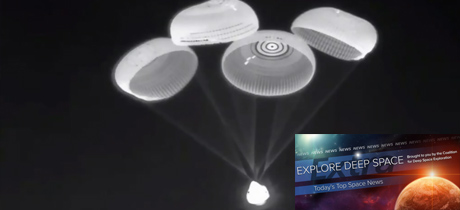In Today’s Deep Space Extra… NASA estimates potential savings from ISS transition. InSight recovers from dust storm. Senate Space and Science Subcommittee plans a hearing on public private partnerships on Wednesday.
Human Space Exploration
NASA outlines cost savings from ISS transition
Coalition Members in the News – Nanoracks, Northrop Grumman
SpaceNews.com (2/6): In a report to Congress updating its plans to transition low Earth activities to commercially provided free flyers, NASA estimates the move will save about $1.8 billion in annual costs by 2033. The transition is to begin in the late 2020s, with the International Space Station (ISS) and potentially multiple commercial space stations flying in orbit at the same time to ensure what NASA hopes would be a smooth transition. The ISS would be deorbited in early 2031, according to the latest version of the strategy update provided by NASA to Congress. The cost savings in 2031 is an estimated $1.3 billion. Part of the estimated cost savings comes from the expectation that NASA will be one of several customers for commercial space stations.
NASA, SpaceX offer reassurances on Dragon parachutes
Coalition Member in the News – Axiom Space
Spacepolicyonline.com (2/4): NASA and SpaceX expressed confidence in the descent parachutes that equip the crew and cargo versions of the Dragon capsules that transport astronauts and supplies to and from the International Space Station, despite evidence one of the four chutes did not fully open in the most recent splashdowns of crew and cargo missions. The agency and the company say they are working to obtain a better assessment of what happened as SpaceX continues to work toward the Axiom 1 private astronaut mission launch on March 30 and NASA’s Crew 4 mission, currently planned for an April 15 liftoff.
Space Science
NASA’s James Webb Space Telescope is cooling down for its next trick: Observing the universe
Space.com (2/6): With the alignment of the segments of the large primary mirror now underway aboard the James Webb Space Telescope (JWST), astronomers are looking to begin science observations in about five months, according to Chief Scientist John Mather of NASA’s Goddard Space Flight Center, in an interview. For the time being, the 18 hexagonal elements of the primary mirror are working as separate telescopes but will soon need to act as a single mirror looking at the deep universe, Mather explained. He also confirmed that “the telescope is cold.” Webb needs to be very cold for its infrared instruments to pick up subtleties in galaxies, exoplanets, and other objects.
InSight recovers from dust storm as lander’s power continues to wane
SpaceNews.com (2/5): NASA’s Mars InSight lander, the first spacecraft mission developed to study the Martian interior, suffered a power loss in January due to a regional dust storm that blocked sunlight from reaching the spacecraft’s electricity generating solar panels, which triggered the lander into safe mode. The storm has passed, but dust continues to accumulate on the panels and the mission appears likely to conclude within a year due to reduced power availability. InSight touched down at Elysium Planitia on Mars on November 26, 2018.
New center to coordinate work to mitigate effect of satellite constellations on astronomy
SpaceNews.com (2/5): The International Astronomical Union has announced plans to initiate the Centre for the Protection of the Dark and Quiet Sky from Satellite Constellation Interference, with operations planned to begin on April 1. The center’s experts will work to address the visible and radio interference associated with constellations of small communications satellites. Their agenda includes the development of software tools for astronomers, work on national and international policies, community outreach, and work with industry on relevant technologies. Obtaining sufficient financing could be a challenge, according to the report.
Other News
Soyuz launches mysterious Neitron military payload
NASAspaceflight.com (2/5): A Soyuz-2.1a rocket that lifted off from the Plesetsk Cosmodrome placed a Russian military satellite, possibly called Neitron, into a high inclination orbit on Saturday.
Major Space Related Activities for the Week
Major space related activities for the week of February 6-12, 2022
Spacepolicyonline.com (2/6): NASA will host a Science Mission Directorate virtual Town Hall on Tuesday at 1:30 p.m. EST, which follows the Space Foundation’s virtual “Start Here For Space: Norms of Behavior,” planned for 1 p.m. to 1:20 p.m. EST. The National Academies of Sciences, Medicine and Engineering’s Committee on Planetary Protection – Small Bodies will host a virtual meeting on Wednesday from 12:30 p.m. until 3 p.m. The U.S. Senate Space and Science Subcommittee plans a hearing on NASA Public-Private Partnerships on Wednesday at 2:30 p.m. EST. On Thursday, NASA will host a virtual news briefing on the science payloads slated to launch to the International Space Station (ISS) aboard the next Northrop Grumman re-supply mission slated to launch no earlier than February 19 at 12:39 p.m. EST. Congress is facing an appropriations deadline of February 18, the expiration date for the current budget continuing resolution for the 2022 fiscal year which began October 1, 2021. It’s unclear as well when the White House plans to submit a budget proposal to Congress for the 2023 fiscal year.

